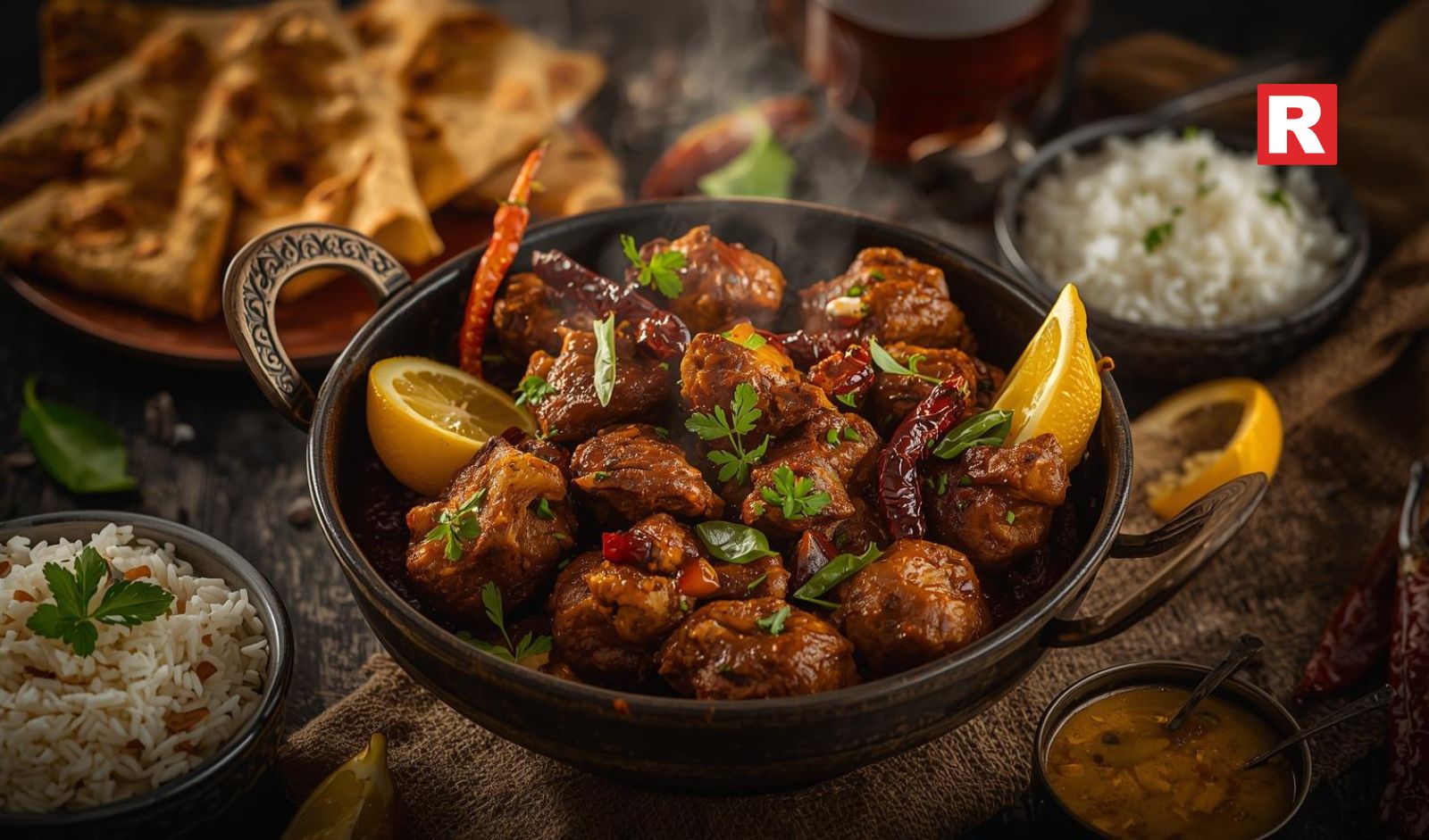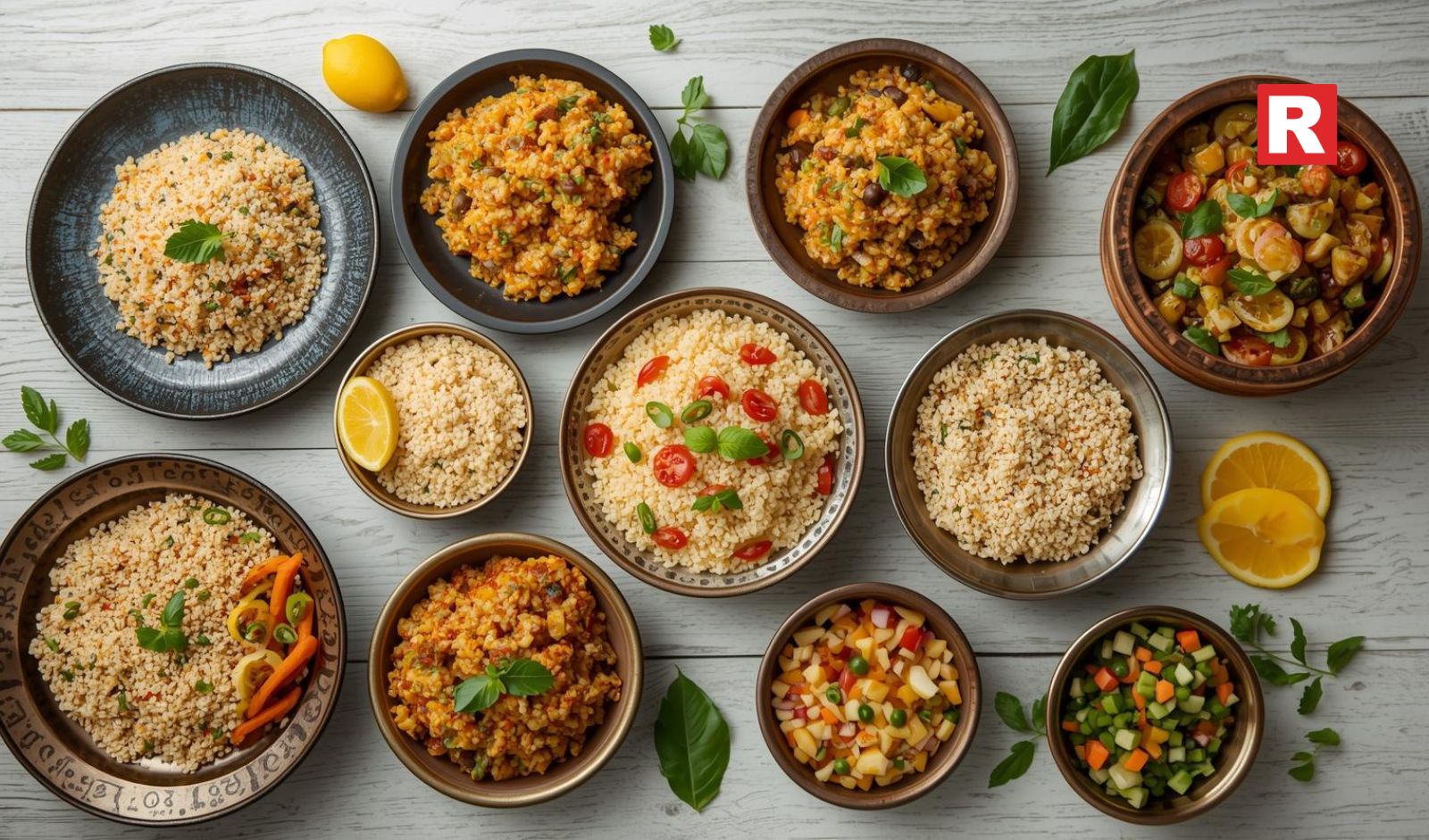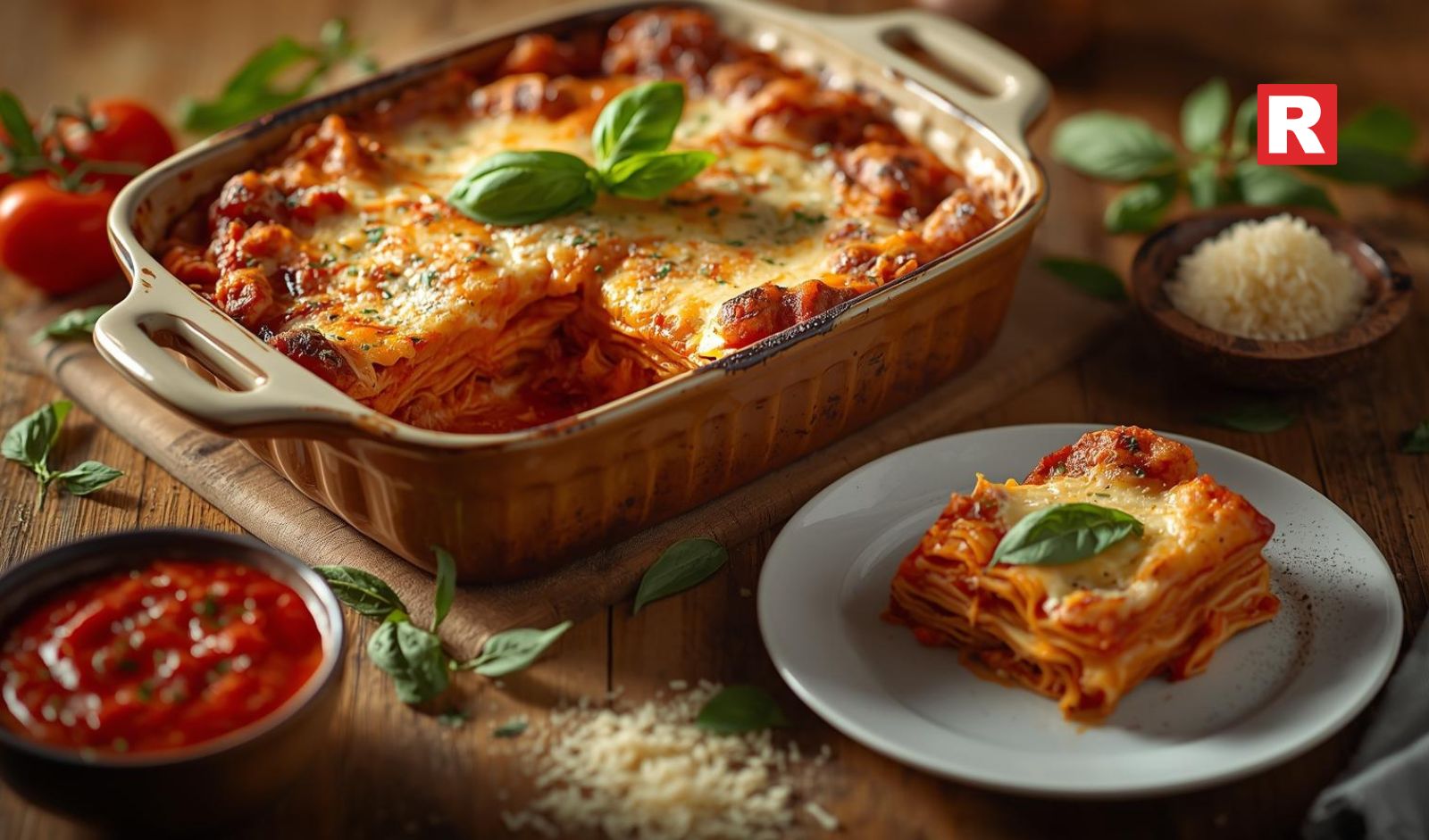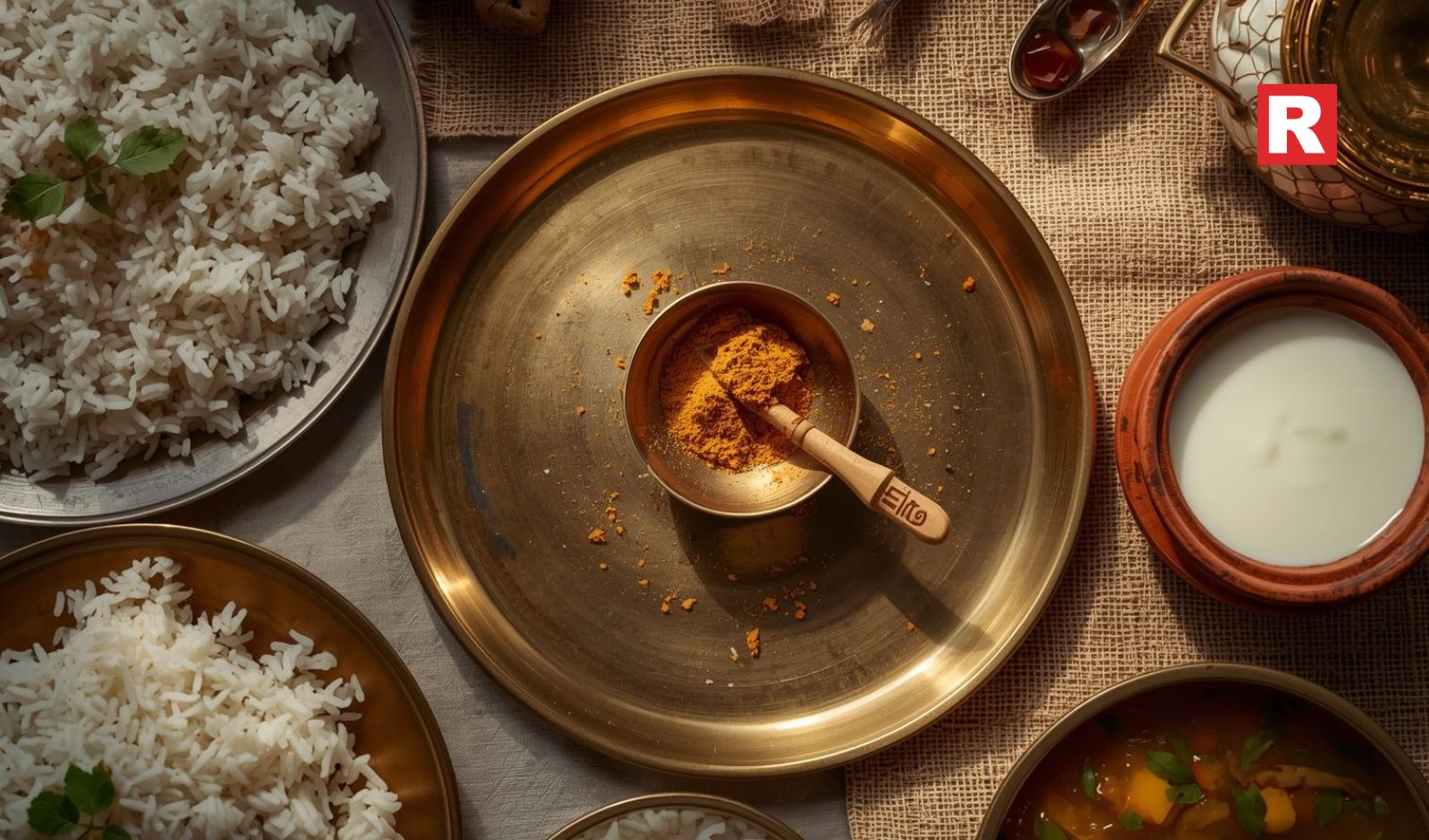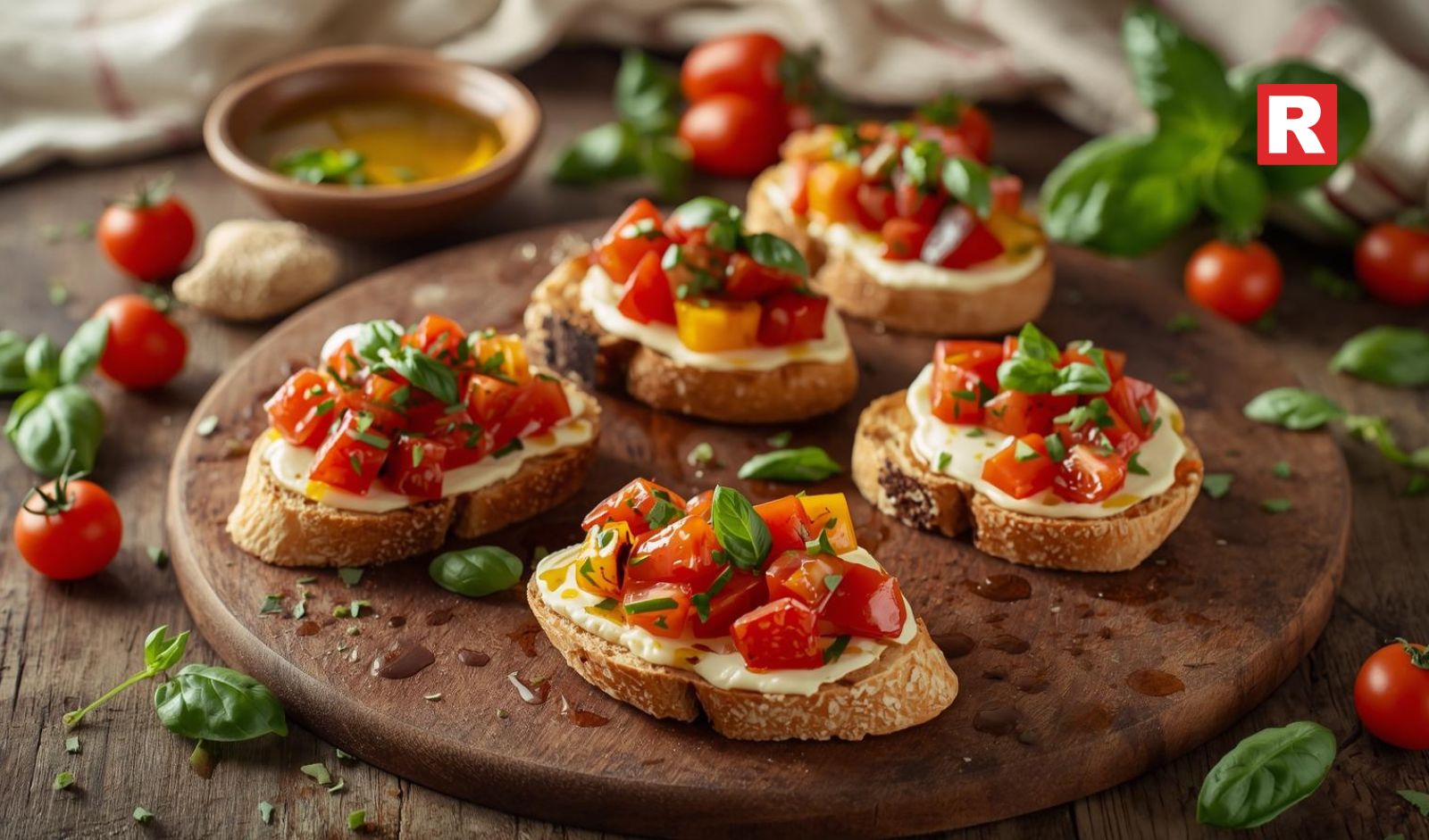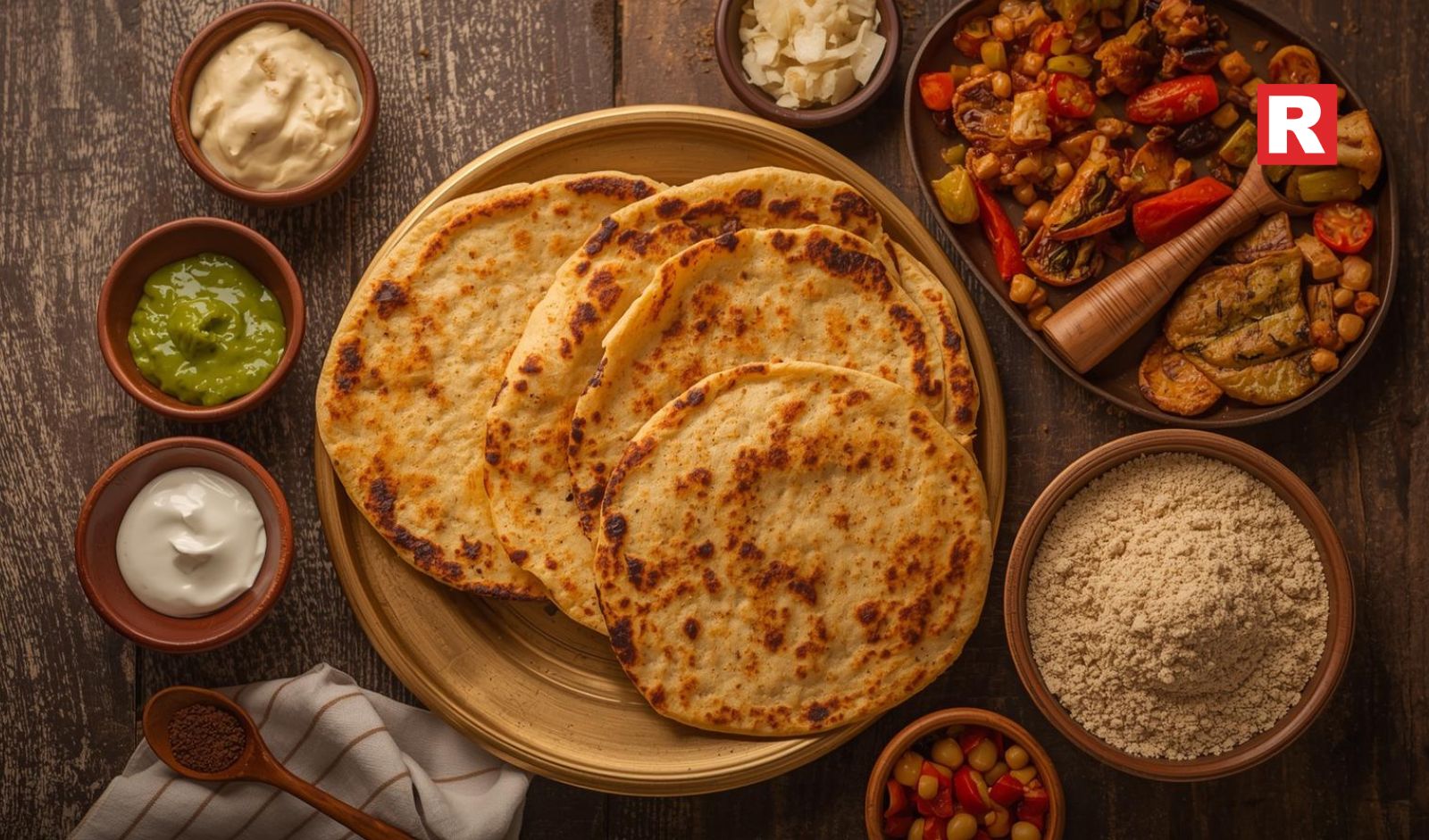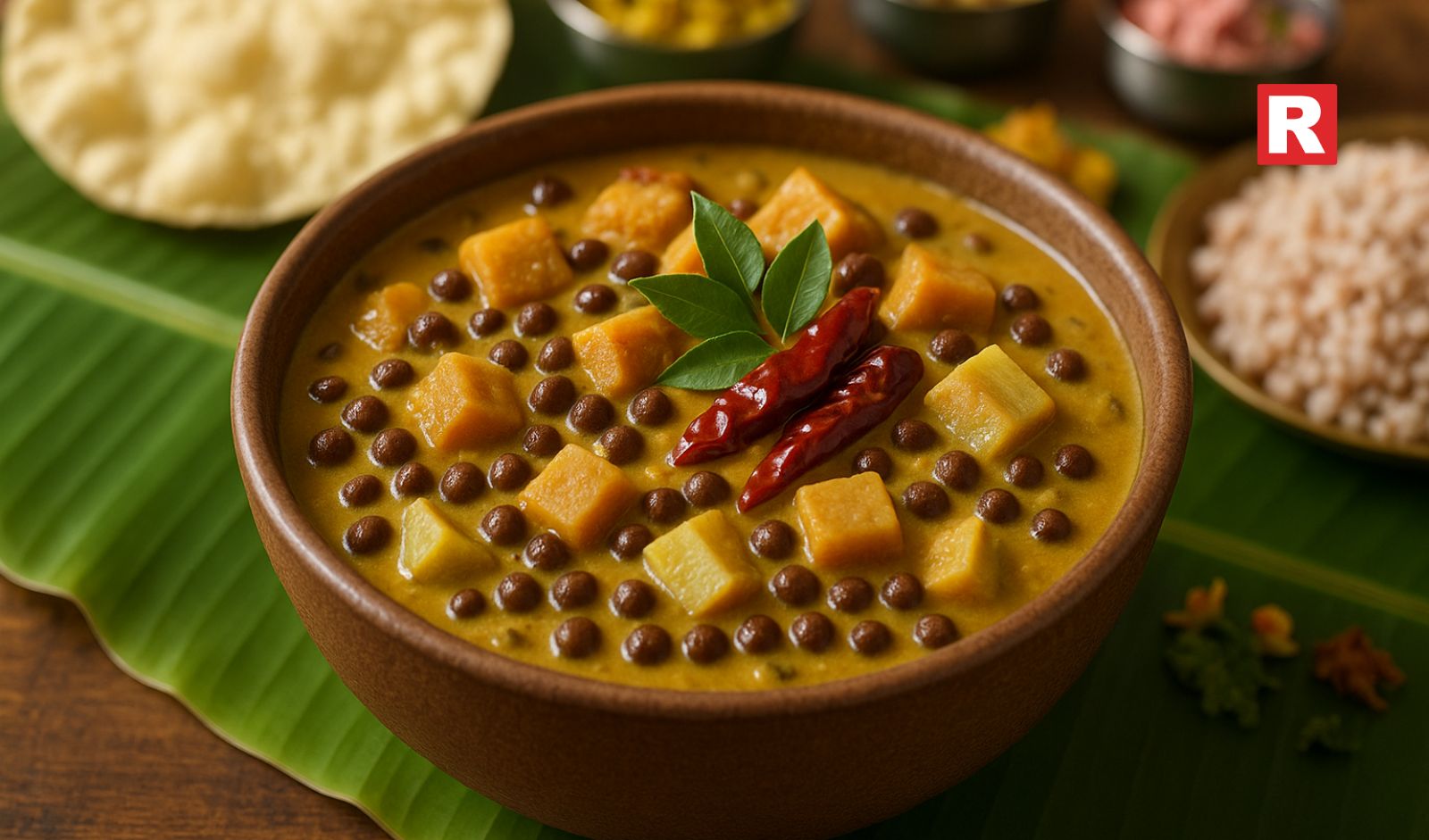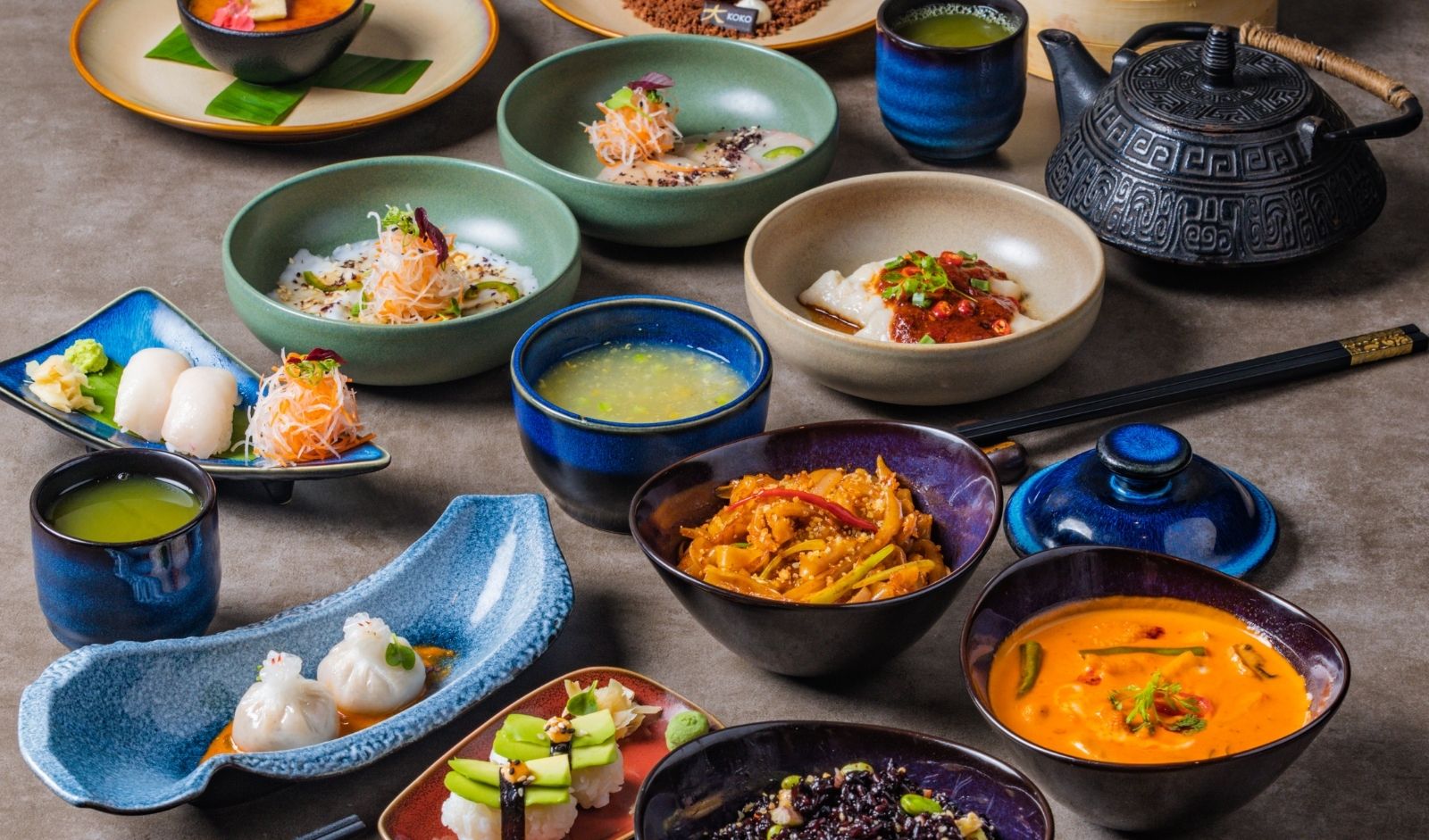
Mutton Chukka, or Mutton Sukka, is a spicy, tasty dry dish from South India. In Tamil, "chukka" means "dry fry," and this dish lives up to its name with juicy pieces of mutton covered in a thick, spicy masala. Mutton Chukka is a restaurant favorite in Tamil Nadu, Kerala, Karnataka, and Maharashtra. It goes great with rice, chapati, or even biryani. Also called as Mutton Fry or Mutton Pepper Fry.
If you're looking for the Madurai Mutton Chukka recipe, a Kerala-style sukka, or a Chettinad version full of spices, each region has its own special twist. Let's learn about the history and meaning of this dish and how to make it at home.
What is Mutton Chukka (Sukka)?
Mutton Chukka (or Sukka) is a dish made with goat meat that is cooked with spices, onions, tomatoes, and curry leaves. It can be semi-dry or dry. This dish is different from gravies in that it should be roasted until the masala sticks to the meat, giving it a strong, spicy flavor. Depending on where you live, it can be spicy with black pepper (Tamil Nadu), coconut-based (Kerala and Mangalore), or nutty and rustic (Maharashtra).
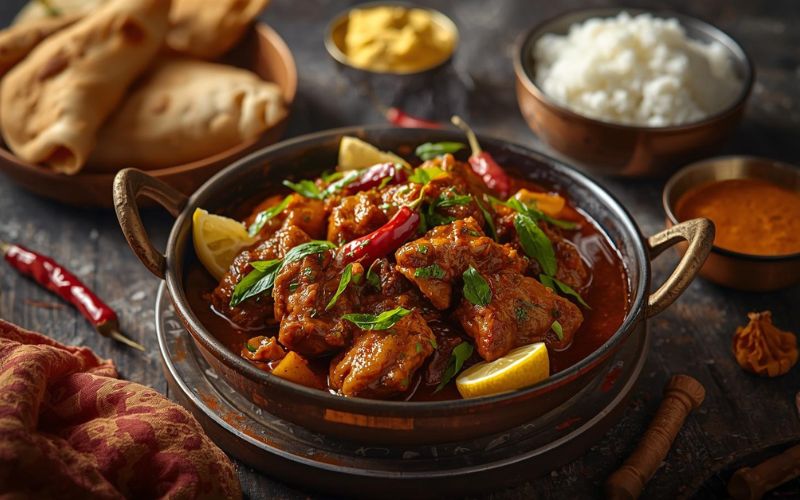
In short, Mutton Chukka is a flavor bomb. It's hot, smoky, and smells great, which is why it's so popular in South Indian homes, messes, and restaurants.
History of Mutton Chukka (Sukka)
Mutton Chukka comes from Tamil Nadu, and it became famous in Madurai, where small messes (local restaurants) made it famous. Traditionally, it was made with goat meat that had just been killed and cooked slowly in iron kadais with local spices and curry leaves.
As time went on, different areas used and changed the recipe:
- Chettinad cooks added their own mix of spices, which included star anise and fennel.
- Kerala added roasted coconut and coconut oil to make it taste better.
- Mangalorean families made it into a Sukka by adding grated coconut.
- Maharashtrian kitchens added goda masala and dry coconut for a nutty kick.
Mutton Chukka is a popular dish in restaurants today and a must-have for festive or celebratory meals in South India and beyond.
What is the Meaning of Mutton Chukka (Sukka)?
The Tamil word "Chukka" means "dry" or "fried." "Sukka" comes from the Hindi and Marathi word "sukha," which also means "dry."
So, "Mutton Chukka" or "Sukka" means "mutton that has been fried dry." This dish gets its name from the fact that it is cooked slowly until all the moisture is gone and the masala coats the meat, making it dry and spicy.
Ingredients for Mutton Chukka Masala Recipe
Before we dive into the cooking, here are the essential ingredients:
- Mutton – 500 g (bone-in pieces preferred)
- Onions – 2 medium (finely chopped)
- Tomatoes – 2 (chopped)
- Ginger-garlic paste – 2 tbsp
- Cury leaves – a handful
- Green chilies – 2 slit
- Red chili powder – 2 tsp
- Coriander powder – 1 tsp
- Black pepper powder – 1 tsp
- Turmeric powder – ½ tsp
- Fennel seeds – 1 tsp
- Garam masala – 1 tsp
- Oil – 3 tbsp
- Salt – to taste
Step-by-Step Recipe: Traditional Way to Cook Mutton Chukka
The traditional Tamil Nadu style Mutton Chukka is cooked slowly so that the spices soak into the meat. This is how:
- Pressure cook the mutton: Wash the pieces of mutton and cook them in a pressure cooker with salt, turmeric, and a little water for 4 to 5 whistles, or until they are soft. Set aside.
- Make the masala base. Put oil in a kadai and heat it up. Then add curry leaves, fennel seeds, and green chilies. Add the ginger-garlic paste after the onions have turned golden.
- Add the tomatoes and spices. Cook the tomatoes with chili powder, coriander powder, and black pepper until the oil separates.
- Mix in the mutton: Add cooked mutton and its stock, stir well, and cook over medium heat until the stock dries up and the spices coat the meat.
- Add garam masala and curry leaves at the end and fry until the dish is semi-dry and smells good.
This is the traditional way to dry fry it, but you can also keep it semi-gravy by not cooking all the stock down.
Popular Variations of Mutton Chukka
- Madurai Mutton Chukka Recipe: This dish is popular in Madurai messes and gets an extra spicy kick from freshly ground pepper and curry leaves.
- This Kerala Style Mutton Chukka (Malayalam Recipe) has a unique taste because it uses coconut oil, roasted coconut bits, and Kerala spices.
- The Mutton Sukka Chettinad Recipe uses Chettinad masala, which is a mix of roasted spices like fennel, star anise, and cloves, to give the dish a strong, earthy flavor.
- Mutton Sukka Mangalorean Style has grated coconut and mild spices. It's a little less spicy but very fragrant.
- Mutton Sukka Maharashtrian Style is made with goda masala, black sesame, and dry coconut, which gives it a nutty and rustic flavor.
What Goes Well with Mutton Chukka?
- Steamed rice with rasam or sambar
- Ghee rice or jeera rice
- Parotta, chapati, or dosa
- Hyderabadi biryani or South Indian biryani platters
Health Benefits of Mutton Sukka
- It is Rich in protein and iron from tender goat meat
- Black pepper and chili aid digestion and metabolism
- Curry leaves and fennel seeds help reduce bloating and improve gut health
- Moderate spice levels may boost appetite
FAQs About Mutton Chukka
Q1. What is the meaning of Mutton Chukka?
“Chukka” means dry fry in Tamil. “Sukka” means dry in Hindi/Marathi. Both refer to dry-cooked mutton with spices.
Q2. Can Mutton Chukka be made semi-gravy?
Yes, you can keep extra stock while cooking to make a semi-gravy version.
Q3. How long should mutton be cooked?
Pressure cooking for 4–5 whistles usually makes it tender, but adjust depending on the cut.
Mutton Chukka (Sukka) always impresses, whether you like the spicy Madurai style, the coconut-rich Kerala style, or the flavor-packed Chettinad style. It's a great way to treat yourself on the weekend or a main dish for family gatherings.
Now you know how to get restaurant-style flavors into your kitchen when you look for "Mutton Chukka recipe in Tamil" or "Mutton Sukka Maharashtrian style."

Quinoa has become a popular food in Indian kitchens because it is high in protein, fiber, and low in calories. If you want to lose weight, this is a healthy alternative to rice and other refined carbs. Quinoa is special because it goes well with Indian spices and dishes like khichdi, dosas, and pulao. These 10 Indian quinoa recipes for weight loss are very detailed. Each one comes with information about its health benefits, nutrition, and how to serve it.
10 Indian Quinoa Recipes for Weight Loss
Quinoa Khichdi
Quinoa khichdi is a healthy, comforting dish that can be made in one pot and is great for lunch or dinner. When you mix quinoa with moong dal, onions, tomatoes, and light spices, it tastes like traditional khichdi but has more protein and fiber. It takes a long time to digest, which keeps you full longer and stops you from snacking when you don't need to. It has a lot of magnesium and iron, and it helps your body use energy, which is important when you're on a diet that limits calories. A bowl of quinoa khichdi with curd on the side is a filling meal that won't make you feel bad.
Lemon Quinoa
Using quinoa instead of rice makes this dish healthier while still keeping the flavor of South Indian lemon rice. It is both refreshing and filling because it has mustard seeds, curry leaves, green chilies, and turmeric in it, and it is finished with fresh lemon juice. Lemon quinoa has a lot of vitamin C, which helps the immune system and detoxify the body. It is also low in fat and calories. The citrus flavor makes it less heavy, which makes it a great light lunch choice in the summer. Adding a bowl of sautéed vegetables to it makes it taste better and is better for you.
Quinoa Upma
Quinoa upma is a filling breakfast that gets your day off to a good start. It has a lot of vegetables in it, like carrots, beans, and peas. It also has antioxidants, fiber, and carbs that take a long time to digest. Quinoa is a better source of protein than rava, which is important for losing weight. It also makes the dish gluten-free. It has the right mix of flavors and nutrients, so it's great for diabetics too. It becomes a full, filling, and healthy South Indian-style breakfast when served with coconut chutney or sambhar.
Quinoa Dosa
Quinoa dosa is a healthy and crunchy twist on the classic dosa. It is made by fermenting quinoa with urad dal and fenugreek. This makes a batter that is light but full of protein. Quinoa dosa has a lower glycemic index than rice-based dosa. This helps keep blood sugar levels stable and stops fat from building up. It has a lot of amino acids, which help repair muscles. This is especially helpful for people who are trying to lose weight and work out at the same time. For a filling and healthy meal, serve it with tomato chutney or sambar.
Quinoa Idli
Soft, fluffy, and steamed to perfection, quinoa idlis are one of the healthiest breakfast options. Since they are steamed and oil-free, they are naturally low in calories but high in nutrition. Quinoa idlis provide protein, calcium, and iron, which help maintain energy levels throughout the day. They also aid digestion due to their light texture and high fiber. Best enjoyed with sambhar and chutney, they make an excellent meal prep option for those who want quick, healthy breakfasts without compromising taste.
Quinoa Pulao
Quinoa pulao is a tasty and healthy meal that is great for lunch or dinner. When you cook it with onions, tomatoes, carrots, beans, and peas, it gives you a good mix of vitamins and minerals along with the protein from quinoa. This version of rice pulao has fewer calories but fills you up more, which is great for losing weight. Adding ginger-garlic and garam masala makes the food taste better and helps with digestion. When you eat it with curd or raita, it makes a healthy, balanced Indian meal that will keep you going for hours.
Quinoa Poha
Quinoa poha is a lighter version of the well-known flattened rice poha. It tastes a lot like the classic, but it has a lot more nutrients because it has curry leaves, onions, turmeric, lemon juice, and coriander in it. Quinoa poha is a great breakfast or snack choice for people who are trying to lose weight because it is high in fiber and low in oil. It cooks quickly, which is great for busy mornings, and it has a lot of protein, so it will keep you full until your next meal. Adding peanuts or sprouts can make it crunchier and give it more protein.
Quinoa Chilla
Quinoa chilla, which is also known as a savory pancake, is a flexible dish made with quinoa flour, besan, and chopped vegetables like onions and tomatoes. It is a great snack or light meal for losing weight because it is high in protein, low in gluten, and low in calories. Adding fresh vegetables to your diet increases your fiber intake, which helps with digestion and makes you feel full. It's a great choice for busy professionals or fitness fans who want a quick but healthy snack because it can be made in less than 15 minutes. Add mint chutney to it for a fresher taste.
Quinoa Vegetable Soup
Quinoa vegetable soup is a great dinner choice, especially for people who like to eat light meals at night. It has a lot of vitamins, minerals, and antioxidants because it is full of vegetables like carrots, beans, and spinach. Because it has quinoa in it, this soup is more filling than a regular vegetable soup. It helps with digestion, keeps you hydrated, and helps you control your late-night cravings. It is low in fat and calories. Adding a little black pepper and lemon juice improves flavor and speeds up metabolism.
Quinoa Salad with Indian Flavors
Quinoa salad is a cool, crunchy choice that makes a great lunch or side dish. When you mix it with cucumber, tomato, onion, carrot, lemon juice, coriander, and a little bit of chaat masala, it adds an Indian twist to the idea of a quinoa salad. It has a lot of fiber, antioxidants, and lean protein, so it's a good choice for people who want a meal that is low in calories but high in nutrients. This salad is especially good for cleaning out the body and speeding up the metabolism, which helps you lose weight naturally.
Also read: Benefits of Drinking Black Coffee
These 10 Indian quinoa recipes for weight loss show that eating healthy doesn't have to be boring or bland. Quinoa fits right in with Indian food, whether it's in khichdi, dosa, or salad. Every meal is full of nutrients, protein, and fiber, and is meant to keep you full while helping you burn calories more quickly. If you switch out one rice-based meal for quinoa every day, you will see a big difference in your weight and health.
Disclaimer: This article is intended for general informational purposes only and should not be considered a substitute for professional medical advice, diagnosis, or treatment. Readers are advised to consult a qualified healthcare professional before making any dietary, health, or lifestyle changes.

One of those foods that instantly makes you feel better is lasagna. Rich sauce, soft pasta sheets, creamy cheese layers, and a golden-baked top make this dish feel both decadent and comforting. Although lasagna originated in Italy, it has made its way into Indian restaurants and homes, frequently with inventive modifications to accommodate regional tastes. This guide covers everything you need to know whether you're looking for the best Italian lasagna recipe, a vegetarian lasagna recipe, or an easy lasagna recipe.
What is Lasagna?
One of the oldest pasta dishes in the world, lasagna (or lasagne in Italian) comes from the Emilia-Romagna region of Italy. Traditionally, it is made up of layers of flat pasta sheets that are baked to perfection and alternated with fillings, cheese, and rich sauces.
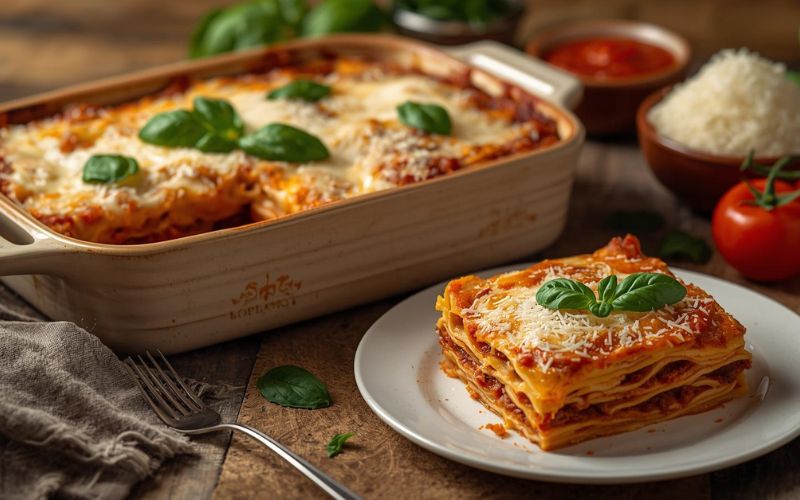
Lasagne is now a common dish in cafes, upscale dining establishments, and home kitchens in India. There is a style for everyone, ranging from traditional Italian lasagna to inventive variations with paneer, spinach, or even chicken.
Ingredients for Lasagna
Good ingredients are the first step to making a great lasagna. Here are the things you'll need:
- Fresh or dried lasagna sheets are the most important part of this dish. Sheets that are ready to go in the oven speed up cooking.
- Vegetable or chicken filling: If you're not a vegetarian, minced chicken or lamb is a great choice. For vegetarian lasagna, you can use spinach, mushrooms, zucchini, or roasted bell peppers, among other things. Paneer gives it a unique Indian touch.
- Tomato sauce is a sauce that cooks slowly and is made with tomatoes, onions, garlic, olive oil, and Italian herbs. This gives it more flavor and depth.
- Cheese: A mix of ricotta, mozzarella, and parmesan makes it creamy and cheesy. A lot of home cooks also use paneer (cottage cheese) instead of ricotta.
- Béchamel, or white sauce, This smooth sauce is made with butter, flour, and milk. It balances out the richness of the dish.
- Seasonings: Fresh basil, oregano, black pepper, and nutmeg will make your kitchen smell like real Italian food.
To make it lighter, use whole-wheat pasta sheets and lots of vegetables.
Step-by-Step Easy Lasagna Recipe
It may seem hard to make lasagna at home, but it's easy if you break it down into steps. This is how to do it:
Make the sauce:
- Sauté onion and garlic in olive oil.
- Add chopped chicken, or keep it vegetarian by using mushrooms, zucchini, or spinach.
- Add the herbs, crushed tomatoes, and puree. Cook on low heat until thick and tasty.
Make the White or Ricotta Layer:
- Béchamel: Mix butter and flour in a pan, then add warm milk and season with salt, pepper, and nutmeg.
- Ricotta Mix: Mix ricotta (or paneer), an egg, parmesan, salt, and herbs together.
Make the Pasta Sheets:
- Boil the lasagna sheets in salted water until they are al dente, then drain. If you're using oven-ready sheets, don't do this.
Layer the Dish:
- Put tomato sauce on the bottom of your baking dish.
- Add the pasta sheets, then spoon on the sauce, béchamel or ricotta mix, and cheese.
- Add more layers until the dish is full, and top with sauce and cheese.
Bake:
- Put foil on top and bake for 30 minutes at 180°C.
- Take off the foil and bake for another 15 to 20 minutes, or until the food is golden and bubbling.
Let it rest and serve:
- Let the lasagna sit for 15 minutes before you cut it. This helps the layers stay together.
Cooking Time for Lasagna
Preparation time: 35–40 minutes
Cooking time: 45–60 minutes
Total time: Around 1 hour 30 minutes
How long to cook lasagna? About 45–60 minutes in the oven at 180°C, plus resting time.
Variations of Lasagna Recipe
You can use lasagna in so many ways. Here are some well-known and Indian-friendly versions:
- Vegetarian Lasagna Recipe: Layer cheese and tomato sauce on top of spinach, zucchini, mushrooms, or roasted eggplant.
- Paneer Lasagna: A mix of Indian and Italian flavors, with cottage cheese and Italian herbs.
- Chicken Lasagna Recipe: Ground chicken in a herbed tomato sauce with cheese and béchamel.
- Vegetable and Ricotta Lasagna: A creamy, healthy version that's great for light dinners.
- Lasagna Soup Recipe: A hearty broth with pasta, vegetables, and cheese that breaks down lasagna.
- Gluten-Free or Zucchini Lasagna: Use thin slices of zucchini instead of pasta sheets to make a lighter, low-carb meal.
Pro Tips for a Perfect Lasagna
- Let the sauce simmer: Always let your sauce cook down until it gets thick. This keeps the lasagna from being watery.
- Roasting vegetables brings out their flavor and keeps the dish from getting soggy.
- Balance the Layers: Don't put too many layers on; 3–4 layers are best for even cooking.
- Use Fresh Cheese: When you grate mozzarella and parmesan yourself, they melt better than when you buy them already shredded.
- Rest Before Cutting: This step is necessary for clean cuts.
Also Read: Bruschetta Recipe
Health Benefits of Lasagna
Lasagna might seem like a treat, but with the right choices, it can be a healthy meal:
- Chicken, paneer, or cheese are all good sources of protein.
- Adding spinach, zucchini, carrots, or mushrooms to your food boosts the vitamins and fiber.
- Calcium-rich foods like ricotta, paneer, and mozzarella make bones stronger.
- Whole-Grain Option: Whole wheat pasta sheets have more fiber and are better for digestion.
Instead of pasta, try using more vegetables, lean chicken, low-fat cheese, and baked zucchini slices.
Read also: Beetroot Pachadi Recipe
FAQs About Lasagna
What are the ingredients in lasagna?
Lasagna sheets, tomato sauce, béchamel or ricotta, mozzarella, parmesan, and fillings like chicken, paneer, or vegetables.
What is the secret to a good lasagna?
A thick, flavorful sauce, balanced layers, and resting time after baking.
What are the three main ingredients in lasagna?
Pasta sheets, sauce, and cheese.
Can lasagna be made without an oven?
Yes, you can layer it in a deep pan, cover with a lid, and cook on low heat until the pasta softens.
Can lasagna be prepared in advance?
Absolutely! Assemble it a day ahead, refrigerate, and bake before serving. It also freezes well.
Lasagna is a dish that adapts beautifully to Indian kitchens. Whether it’s a vegetarian lasagna recipe with spinach and paneer, or a chicken lasagna recipe for meat lovers, this Italian classic always delivers comfort and flavor. With a little patience and layering technique, you can create the best lasagna recipe right at home—perfect for family gatherings, festive occasions, or weekend indulgence.

People love the simple, tasty, and healthy Maharashtrian dish metkut. You can mix this roasted spiced powder with rice, ghee, or curd to make a healthy and filling meal. This dish is very important in Maharashtrian homes, especially when someone is sick, fasting, or needs something light but filling. You can call it paramparik metkut (traditional metkut) or just metkut powder.
This article will cover everything you need to know about metkut, including its ingredients, how to make it, different ways to use it, and its health benefits.
Read also: Sattu Paratha Recipe
What is Metkut?
Metkut is a fine, roasted powder made from lentils (like chana dal, urad dal, and moong dal), rice, and spices like cumin, coriander, turmeric, and asafoetida. The mixture is roasted until it is dry and then ground into a fine powder. It is one of the healthiest comfort foods in Maharashtrian cuisine and is usually served with hot rice and ghee.
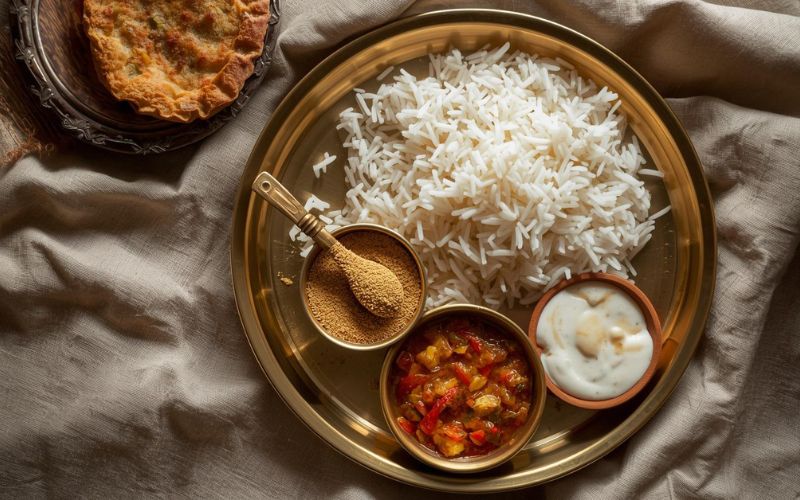
Metkut is a light and easy-to-digest food that kids, older people, and people who are sick love.
Ingredients for Metkut Recipe
Here are some ingredients that are often used:
- Rice, chana dal, urad dal, moong dal, and wheat are all grains and lentils.
- Cumin seeds, coriander seeds, black pepper, mustard seeds, turmeric powder, hing (asafoetida), and fenugreek seeds are all spices.
- For more smell, you can add curry leaves.
Read also: Kootu Curry Recipe | Bruschetta Recipe
Step-by-Step Method for Metkut Recipe
Making metkut at home may seem easy, but the secret is in the right way to roast the ingredients and the right amount of each one.
- Start with rice and lentils (chana dal, urad dal, and moong dal) and dry roast them. Roast each one on a medium flame until it turns a little golden and smells like nuts. This step is very important because lentils that aren't roasted enough will taste raw, and lentils that are roasted too much will make the powder taste bitter.
- Roast the spices next. Roast the cumin seeds, coriander seeds, fenugreek, and black pepper until they smell good. At the very end, add hing (asafoetida) and turmeric. These spices release their flavor quickly.
- Cool the Right Way: Put the roasted foods on a plate to cool all the way down. When you grind warm spices, the powder can stick together.
- Grind to a Fine Powder: A good grinder will make the texture smooth. People in traditional households often sift the powder once to make sure it is fine.
- Store Airtight: Put the metkut powder in a clean, dry glass jar. It stays fresh for 3 to 4 months if you store it right.
Pro Tip: Always roast on low to medium heat to get the best flavor and even cooking.
How to Eat Metkut
Depending on your mood, health, and the time of year, you can enjoy metkut in a variety of ways:
- Classic Comfort Food: The most common way to eat metkut is to mix 1–2 teaspoons with hot steamed rice and top it with a spoonful of ghee. This mix is light but filling, especially after a long day.
- With Curd or Buttermilk: In the summer, people mix metkut with curd rice or buttermilk to make a meal that cools the stomach and is full of probiotics.
- As a Healing Meal: Plain metkut rice with not too much ghee is a natural food that helps people get better after they have a fever or an upset stomach.
- On the Go: Many families from Maharashtra take metkut with them when they travel. It only takes hot rice or even water to make a meal that fills you up right away.
Metkut is like "comfort in a bowl" for India: it's simple, healthy, and always there when you need it.
Popular Variations of Metkut Recipe
Families make metkut in different ways, depending on their tastes and traditions.
- Mild Metkut has less black pepper and chili, so it's good for kids and older people with sensitive stomachs.
- Spicy Metkut has more pepper and sometimes a little bit of red chili powder for people who like things to be spicy.
- Multigrain Metkut has lentils, wheat, jowar, or bajra in it, which makes it more nutritious and fiber-rich.
- MadhurasRecipe Style – This version is popular with foodies because it combines old-fashioned flavors with modern presentation. It often goes viral online.
- Regional Twists: Some families add curry leaves or sesame seeds to the roasting process to give it an earthy, nutty flavor.
Each version shows how one recipe can change over time to fit the tastes and traditions of different families.
Uses of Metkut Powder
Metkut powder can be used on more than just rice. It's surprisingly flexible:
- Instant Meal Maker: If you don't want to cook, mix it with rice, ghee, and pickles for a quick and healthy meal.
- For Khichdi or Dal, add a spoonful of this topping to soft khichdi or plain dal to make it taste better.
- Food for travel— It's light, doesn't go bad, and is easy to carry, so it's great for train rides and picnics.
- Baby and Elderly Food: A lot of families start giving it to their kids early on and serve it to older people who like soft, mild food.
- Soup Base: To make a quick, digestive soup, add a little metkut to hot water or buttermilk with a pinch of salt.
Metkut shows that you can turn simple ingredients into a food that goes with everything.
Health Benefits of Metkut
Not only is metkut delicious, but it also has a lot of health benefits that make it a classic recipe:
- Spices like hing, cumin, and fenugreek are natural digestive aids that can help with bloating and indigestion.
- Lentils in metkut are high in protein and fiber, which is good for your gut health.
- Light on the Stomach: Metkut is light, unlike oily curries, so it's great for recovering from illness or as a detox meal.
- Cooling in the summer: When mixed with curd or buttermilk, it cools the body naturally.
- Spices like turmeric and black pepper can help your immune system by reducing inflammation and killing bacteria.
- Safe for Everyone – It works for people of all ages, from toddlers to seniors, because it is both healthy and gentle.
Metkut vs Paruppu Podi: Are They the Same?
While Metkut (Maharashtrian) and Paruppu Podi (South Indian) are similar roasted lentil powders, they differ in taste and spice profile. Metkut is milder, focusing on digestion and light meals, whereas paruppu podi usually has a stronger, spicier flavor with garlic or curry leaves.
Metkut is more than just a recipe; it's a tradition that has been passed down through the years. This Maharashtrian classic is still the best for comfort food, quick meals, or as a natural way to help with digestion. Make some homemade paramparik metkut powder if you haven't already. You'll taste the true taste of simplicity.

You're in the right place if you want a simple, tasty, and flexible Italian bruschetta recipe. Bruschetta (pronounced broo-skeh-tah) is one of the most popular Italian appetizers. It is toasted bread with garlic rubbed on it and fresh, tasty toppings. If you like quick but fancy food, you have to try this recipe. It's great as an appetizer, snack, or party dish.
What is Bruschetta?
Bruschetta is a classic Italian dish made with slices of rustic bread that are grilled or toasted, rubbed with garlic, and topped with olive oil, salt, and seasonal ingredients. The most popular topping is a mix of tomatoes, basil, and olive oil. However, variations with mozzarella, cheese, and Indian spices are also very popular these days.
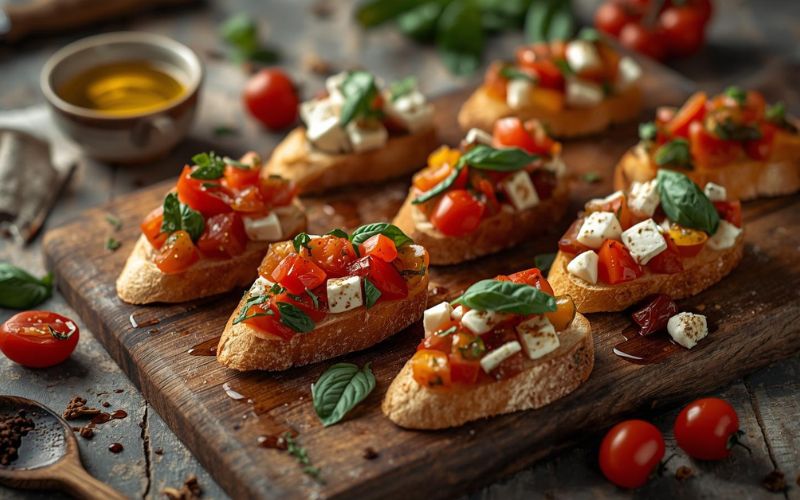
Ingredients for Classic Italian Bruschetta
To make real Italian bruschetta, you need the following:
- 1 baguette or rustic Italian bread
- 2–3 cloves of garlic
- 3–4 ripe Roma tomatoes (or cherry tomatoes)
- 2–3 tbsp extra virgin olive oil
- Fresh basil leaves
- Salt and pepper to taste
- Optional: balsamic vinegar drizzle
Step-by-Step Recipe for Italian Bruschetta:
Step 1: Get the bread ready
- Cut the bread into medium-thick pieces on the diagonal.
- Put olive oil on each slice and toast them on a grill pan or in the oven until they are golden and crisp.
Step 2: Rub with Garlic
- Cut a clove of garlic in half and gently rub it over the hot bread. This adds a great flavor without being too strong.
Step 3: Prepare the Topping
- Chop the basil leaves and dice the tomatoes. Then mix them with olive oil, salt, and pepper.
- You can add a splash of balsamic vinegar to make it taste better.
Step 4: Put everything together and serve
- Put the tomato mix on the bread that has been toasted.
- Add more basil to the top and serve right away.
Popular Variations of Bruschetta Recipe
Bruschetta is great because you can use it in so many ways. The classic Italian bruschetta recipe calls for tomatoes and basil, but there are many ways to change it up:
- Bruschetta with Mozzarella: The fresh mozzarella makes the crunchy toast and juicy tomatoes taste even better. Before serving, melt the mozzarella a little bit under the grill for an extra touch.
- Bruschetta with Cheese: You can use parmesan for a salty kick, ricotta for a soft spread, or even feta for a tangy twist. Paneer cubes can also be a tasty substitute in India.
- Veg Bruschetta Recipe: Add roasted vegetables like bell peppers, zucchini, eggplant, or mushrooms to your bruschetta. This makes it filling, colorful, and great for vegetarians.
- Add a desi twist to the Indian bruschetta recipe by adding green chilies, cumin, or chaat masala to the tomato mix. You could even add a spoonful of mint chutney or coriander leaves on top for a fusion touch.
- Bruschetta Jamie Oliver Style: To bring out the flavors, use ripe cherry tomatoes, a splash of red wine vinegar, and high-quality olive oil.
These different types of bruschetta make it good for almost any taste, from real Italian to Indian street food!
Read also: Sattu Paratha Recipe
Pro Tips for Perfect Bruschetta
It looks easy to make bruschetta, but a few smart tips can make it even better:
- Pick the Right Bread: Choose rustic Italian bread, a baguette, or sourdough. Don't use very soft sandwich bread because it won't hold the toppings well.
- Don't Burn, Toast: The bread should be golden and crunchy, not hard or burnt. Grilling on a grill pan gives food nice char marks and extra flavor.
- Use fresh ingredients. The quality of the tomatoes, olive oil, and basil makes a big difference. Always choose ripe tomatoes and high-quality extra virgin olive oil.
- To keep it from getting soggy, only put together bruschetta when you're ready to serve it. If you leave the toppings on the bread for too long, it can get soggy.
- Try different toppings. Don't be afraid to mix and match, like Indian masalas and Mediterranean olives. Bruschetta is meant to be adaptable.
If you follow these steps, your easy bruschetta recipe will taste just as good as one from an Italian trattoria.
Read also: Kootu Curry Recipe | Beetroot Pachadi Recipe
Health Benefits of Bruschetta
Bruschetta is not only tasty, but it's also a healthier snack than deep-fried ones. This is why:
- Good Fats for Your Heart: The olive oil in bruschetta is full of good fats that are good for your heart.
- Fresh Vegetables: Tomatoes are full of antioxidants like lycopene, which are good for your skin and immune system. Adding more vegetables only makes it healthier.
- Bruschetta is a light and healthy snack or appetizer that is low in calories but still filling.
- Protein Options: Adding mozzarella, paneer, or ricotta gives it more protein, making it a balanced mini-meal.
- Whole Grain Boost: Adding fiber to the bread makes it even healthier. Use whole-grain or multigrain bread.
Bruschetta is a healthy Italian appetizer that people all over the world love. It can easily fit into a vegetarian or weight-conscious diet if you choose the right bread and toppings.
Bruschetta shows that you can make amazing flavors with just a few simple ingredients. This dish is always a hit, whether you stick to the Italian bruschetta recipe or try adding Indian spices and cheese. You can see why it's one of the most popular starters in the world if you try it at home today.

People in Kerala love Beetroot Pachadi, especially during Onam Sadya and other holidays. This colorful dish is a great side dish for rice because it has the sweetness of beetroot, the tang of yogurt, and the smell of coconut. There are small differences in the recipes depending on where you live. For example, there is the Malayalam style Beetroot Pachadi recipe, the Andhra style Pachadi, and even versions without coconut.
This guide has everything you need to know about Beetroot Pachadi, from a simple recipe to its health benefits and different ways to make it.
What Exactly is Beetroot Pachadi?
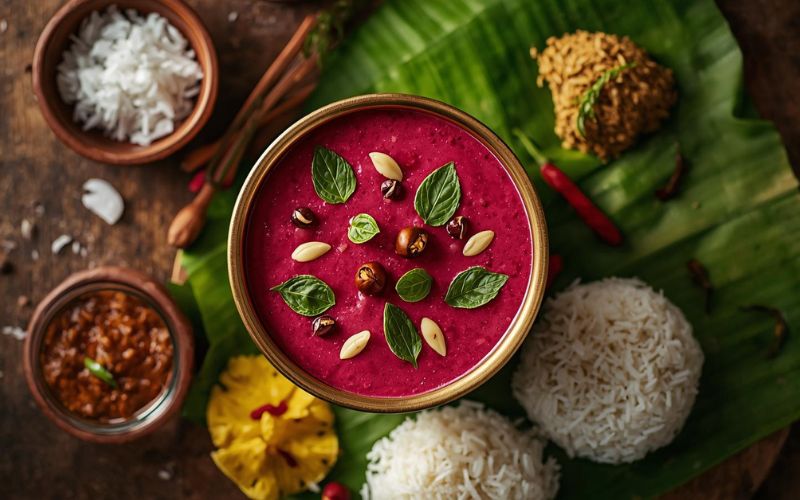
Beetroot Pachadi is a South Indian dish that is similar to raita. It is made by mixing cooked beetroot with a paste made from ground coconut and mustard and then mixing it with curd (yogurt). Adding curry leaves, mustard seeds, and dry red chilies to the dish gives it a tasty finish.
Pachadi tastes different from the usual North Indian beetroot raita because it has coconut and curry leaves in it.
Also read: Kootu Curry Recipe
Ingredients for Beetroot Pachadi (Malayalam Recipe)
Here is a list of the usual ingredients used in a Malayalam recipe for beetroot pachadi:
- 2 medium beetroots, grated or finely chopped
- ½ cup grated fresh coconut
- 2–3 green chilies
- 1 tsp mustard seeds
- 1 small piece ginger
- 1 cup thick curd (yogurt)
- ½ tsp turmeric powder
- 1–2 dried red chilies
- 1 sprig curry leaves
- 2 tsp coconut oil
- Salt as needed
Step-by-Step Beetroot Pachadi Recipe
- To cook the beetroot, put grated beetroot, turmeric, salt, and a little water in a pan. Cook until soft.
- Make the paste out of coconut – With a little water, grind the grated coconut, green chilies, ginger, and half of the mustard seeds into a smooth paste.
- Mix with beetroot: Stir this paste into the cooked beetroot and let it simmer for 2–3 minutes.
- Mix in some yogurt after the mixture has cooled down a bit.
- To make tempering, heat coconut oil and add mustard seeds, curry leaves, and dry red chilies. Add this to the pachadi.
- Serve: As part of a Sadya meal, Beetroot Pachadi is ready to be served with steamed rice.
Beetroot Pachadi Variations
- Beetroot Pachadi without Coconut: For a lighter version, mix cooked beetroot with curd, salt, and a tempering of mustard and curry leaves instead of coconut paste.
- Andhra Beetroot Pachadi is spicier than other styles. It has a sour taste because it uses tamarind pulp and red chilies instead of Kerala style.
- If you're short on time, just cook the beetroot, mix it with curd, and add a quick tempering. You don't need to grind anything.
- Pineapple Pachadi is a festive version made with pineapple instead of beetroot. It is also very popular in Kerala Sadya.
Also read: Sattu Paratha Recipe
Health Benefits of Beetroot Pachadi
Beetroot Pachadi is not only delicious but also highly nutritious:
- Rich in Iron & Folate: Helps in improving blood circulation and preventing anemia.
- Gut-Friendly: Yogurt provides probiotics that support digestion.
- Low-Calorie Side Dish: Makes it ideal for health-conscious eaters.
- Detox Friendly: Beetroot aids in liver detoxification.
- Heart Health: Coconut oil and curry leaves add good fats and antioxidants.
So, if you’re asking “Is beetroot pachadi good for health?” – the answer is a big yes. It’s a wholesome dish that balances taste and nutrition.
Pro Tips to Make Perfect Beetroot Pachadi
- Use thick curd every time to keep the pachadi from getting watery.
- Don't add curd to the beetroot mixture while it's still hot. Let it cool down a bit first to keep it from curdling.
- Use coconut oil to temper the food; it brings out the real Kerala flavor.
- Add green or red chilies to change the heat level to your liking.
- If you want a smoother texture, grate the beetroot; if you want a chunkier pachadi, chop it up.
What Goes Well with Beetroot Pachadi?
The best things to eat with beetroot pachadi are:
- Avial, Erissery, Parippu Curry, and Rice are some of the Kerala Sadya dishes.
- Steamed rice with sambar or rasam is easy to make.
- You can also eat it as a side dish with chapati or dosa.
One of those dishes that instantly brings the tastes of Kerala to your plate is Beetroot Pachadi. If you like South Indian food, you have to try this pachadi. It comes in three different styles: the traditional Malayalam style, a simple style without coconut, and a spicy Andhra style.
Beetroot Pachadi is a great dish to make for a special occasion or to add some color and health to your thali.

Sattu Paratha is a very important part of a traditional Indian breakfast. This simple paratha stuffed with roasted gram flour comes from Bihar and Jharkhand. It's a full meal on its own—tasty, filling, and full of nutrients. For a lot of families, food is more than just food; it's a way to connect with their roots. This article is your one-stop shop for everything you need to know about Bihari-style cooking, whether you're trying the real thing, looking for versions from Hebbars Kitchen or Nisha Madhulika, or asking Sanjeev Kapoor for expert advice.
What Makes Sattu Paratha Special?
Sattu is roasted Bengal gram flour that is often called "poor man's protein." Because it is cheap, high in protein, and gives you energy, it has been a staple for farmers and workers for hundreds of years. Biharis even say that a meal of sattu can keep you going all day.
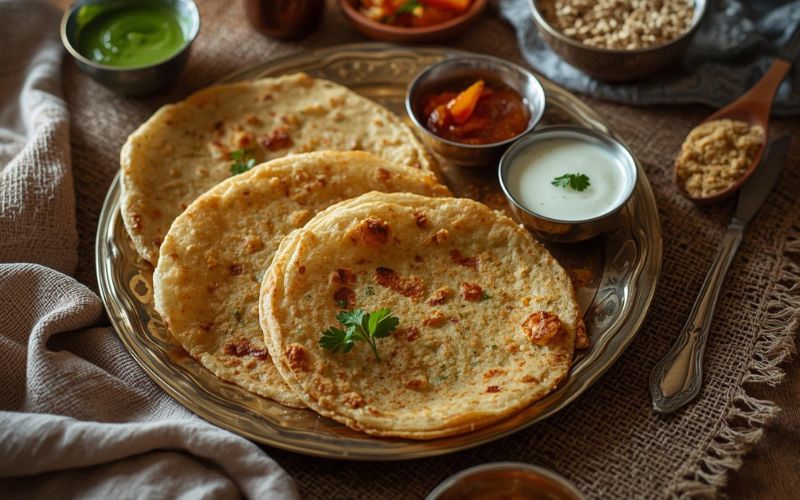
Sattu Paratha tastes different from regular stuffed parathas like aloo or paneer because it has a unique earthy flavor from roasted gram and mustard oil. This mix of taste, health, and history is what makes it last forever.
Ingredients of Sattu Paratha
To make this healthy meal, you will need:
For the dough
- 2 cups of flour made from whole wheat
- A little bit of salt
- 1 teaspoon of ghee or oil
- Water, as needed
For the Filling
- 1 cup of sattu (roasted gram flour)
- 1 medium onion, cut up very small
- 2 green chilies, finely chopped
- 1 tsp of ginger-garlic paste
- 2 tablespoons of chopped fresh coriander leaves
- 1 to 2 teaspoons of pickle masala or amchur (for tang)
- ½ teaspoon ajwain (carom seeds)
- Salt, to taste
- 1 to 2 tablespoons of mustard oil (this is what gives it its real flavor)
- A few drops of lemon juice
Step-by-Step Sattu Paratha Recipe
Step 1: Make the Dough
- Mix together the ghee, flour, and salt. Slowly add water and knead the dough until it is soft.
- Put a wet cloth over it and let it sit for 20 to 25 minutes to make it more elastic.
Step 2: Get the stuffing ready
- Put the sattu, onion, chili, coriander, spices, and ajwain in a bowl and mix them together.
- Add lemon juice and mustard oil; these are what keep the stuffing moist and tasty.
- Change the spices to suit your taste.
Step 3: Put the Paratha together
- Make equal balls of dough and roll each one into a small circle.
- Put 2–3 spoonfuls of stuffing in the middle.
- Carefully seal the edges and roll the paratha gently so that the stuffing doesn't spill out.
Step 4: Roast the Paratha
- Put the rolled paratha on a hot tawa.
- Cook on medium heat with ghee or oil until golden brown spots show up.
- Serve with curd, pickle, or chokha while it's hot.
Pro Tips to Make Perfect Sattu Paratha
It's easy to make a good Sattu Paratha, but it's hard to make a perfect one. Here are some ways to make your parathas better:
- Moisture is key: Sattu is usually dry, so adding mustard oil, lemon juice, or a little bit of water will keep the filling soft and tasty. The paratha will break or taste bland if the stuffing is too powdery.
- Make sure the filling and dough are even: If you put too much filling in, the paratha will tear, and if you don't put enough in, it will be flat. As a general rule, the filling should weigh about half as much as the dough ball.
- Let the dough rest: Let it sit for at least 20 to 25 minutes. This makes gluten relax, which makes the paratha softer and easier to roll.
- How you roll matters: Roll gently and with even pressure. If you roll too hard, the stuffing might come out. If it does, just use a little dry flour to fix it.
- Cook on medium heat. If the heat is too high, the paratha will burn and the inside will be raw. If the heat is too low, the paratha will be chewy. A tawa that is medium-hot makes the outside crispy and the inside soft.
- When roasting, don't forget the ghee or oil. They give the paratha its flaky layers and rich flavor. You can use ghee instead of mustard oil if you want something more decadent.
- Serve right away: When served hot, sattu parathas taste the best. Wrap them in a cotton cloth to keep them soft if you're making them ahead of time.
Also Read: Kootu Curry Recipe
Why is My Sattu Paratha Dry?
Dryness is one of the most common complaints. Some of the reasons are:
- Putting less oil in the stuffing. In the Bihari style, mustard oil is a must.
- The dough is too stiff, which makes the paratha hard.
- Not serving right away—parathas taste best when they're hot.
To make it more fusion-like, add a spoonful of curd or mashed potato to the stuffing.
Health Benefits of Sattu Paratha
Sattu Paratha is not only tasty, but it's also one of the healthiest traditional Indian breakfasts. Here's why you might want to add it to your diet:
- Sattu is roasted chana flour, which is a great source of plant protein. It helps muscles heal and gives you energy for a long time, which is great for kids who are growing and adults who work.
- High in Fiber: Sattu and whole wheat are high in fiber, which keeps digestion moving, stops constipation, and helps keep the gut healthy.
- Cooling Effect on the Body: Sattu is traditionally eaten in the summer because it cools the body and stops heat strokes. This is why it is popular in Bihar and Jharkhand, where it is hot.
- Balances Energy Levels: Sattu releases energy slowly, which keeps you full longer than snacks made with refined flour. Best for diabetics when eaten with little ghee.
- Weight Management: Because it keeps you full for a long time, it stops you from wanting things you don't need, making it a great choice for people who are trying to lose weight.
- Heart-Friendly: Mustard oil is good for your heart when you eat it in moderation because it is high in omega-3s and antioxidants.
- Sattu is full of nutrients like calcium, magnesium, and iron, which are important for strong bones and a strong immune system.
Calorie Check: A medium-sized Sattu Paratha has about 220 to 250 calories. When you eat it with curd and chutney, it becomes a healthy, balanced meal that isn't too heavy.
Variations of Sattu Paratha
The classic Bihari-style Sattu Paratha is the best, but you can try these fun variations based on your taste and the event:
- Bihari Style: The stuffing has raw mustard oil, ajwain, and pickle masala in it. It tastes sharp and earthy, and it's the most real version.
- Without Stuffing: Instead of making a filling, mix sattu right into the dough. This version is easier to roll, which makes it great for beginners. Compared to the stuffed one, it's lighter but not as tasty.
- With Vegetables: Mix in some grated carrot, radish, or beetroot to the stuffing. This not only makes the taste better, but it also makes the nutrition better, which is great for kids who don't like plain sattu.
- For a softer, creamier stuffing, mix sattu with paneer or mashed potatoes. This mix makes the paratha wet and easy for kids to eat.
- Inspired by Celebrity Chef Sanjeev Kapoor, he says to try using herbs like mint and a mix of ghee and oil for roasting to give it a restaurant-like touch.
- Hebbars Kitchen and Nisha Madhulika have online versions. These often make the recipe easier by showing you how to do it step by step and with videos, which is great for people who are cooking for the first time.
- Mini Sattu Parathas: Instead of making big ones, roll out smaller ones that are the right size for snacks. Great for lunch boxes or as a party starter.
Cultural Significance
Bihar's identity is tied to Sattu Paratha, which is more than just food. People in rural areas cook it every day, especially in the summer when heavy curries can be too much. Many Bihari immigrants also bring packets of sattu flour with them when they move abroad, keeping this tradition alive around the world.
Making Sattu Paratha at home is a fun thing to do if you've never done it before. It's simple, healthy, and based on tradition, so it's great for anyone who wants real Indian flavors and a boost in nutrition. You can see why people have loved this dish for generations when you serve it with curd, chutney, or chokha.
So the next time you ask yourself, "What is the healthiest paratha to make at home?" — you already know the answer: Sattu Paratha.

Kootu Curry, or Koottukari, is more than just another vegetarian curry. It's a key part of Kerala's Onam Sadya and other festive meals. This dish is known for its hearty texture and comforting flavors. It combines legumes like black chana (kadala) or Bengal gram with vegetables grown in the area, like yam, ash gourd, raw banana, or pumpkin. The roasted coconut base of Kootu Curry is what makes it stand out. It has a nutty, fragrant flavor that is very Kerala.
Every part of Kerala has put its own spin on Kootu Curry, from the Brahmin homes in Palakkad to the feasts in Kannur and the kitchens in Malabar. This makes it one of the most flexible dishes in Kerala cuisine.
Also Read: Sattu Paratha Recipe
The Story Behind Kootu Curry
Food is very important to Kerala's culture and celebrations. The big Sadya meal served on banana leaves during Onam has more than 20–25 dishes, and Kootu Curry is always the main dish. Kootu Curry is different from the light stews and yogurty curries in the spread because it has a strong, earthy flavor from the mix of roasted coconut, black pepper, and curry leaves.
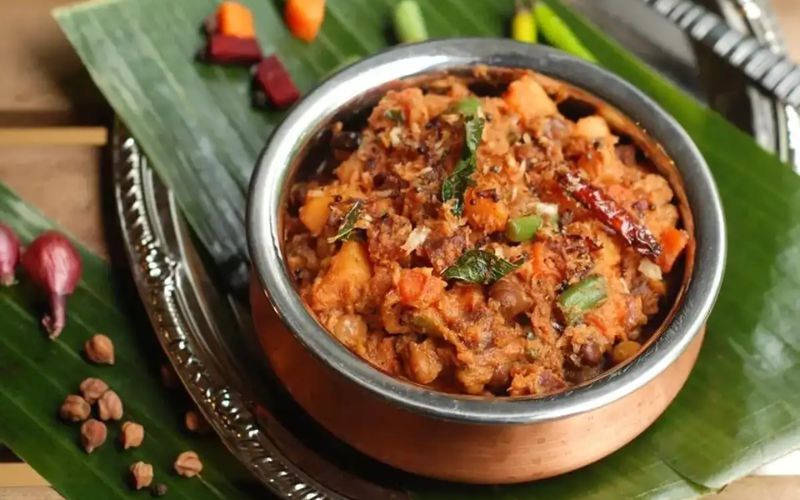
The recipe is passed down from generation to generation in many families. The Palakkad style is simpler and has a hint of coconut, while the Kannur style is stronger, spicier, and has more roasted coconut. The Brahmin version doesn't use onions or garlic, so it's a sattvic dish.
Ingredients in Kootu Curry
A normal Kerala-style Kootu Curry recipe calls for:
- Legumes: Bengal gram or black chickpeas (kadala) soaked overnight and then cooked under pressure
- Yam, raw banana, ash gourd, or pumpkin (often in combination) are some of the vegetables.
- Turmeric, black pepper, red chili powder, green chilies, and curry leaves are some of the spices used.
- Coconut base: Freshly grated coconut roasted with cumin and chilies until golden brown, then ground into a paste.
- Coconut oil, mustard seeds, curry leaves, and dried red chilies are used to temper.
The end product is a thick, mildly spicy curry that tastes great.
Step-by-Step Kootu Curry Recipe (Kerala Style)
- Cook the legumes – Pressure cook soaked black chickpeas or Bengal gram until tender.
- Prepare vegetables – Dice yam, raw banana, or pumpkin into medium cubes. Cook until soft but not mushy.
- Roast and grind coconut – In coconut oil, roast grated coconut with green chilies and cumin until golden brown. Grind into a coarse paste with little water.
- Mix everything – Add the cooked vegetables and legumes together in a pot, stir in the coconut paste, and simmer until flavors meld.
- Temper to finish – Heat coconut oil, splutter mustard seeds, toss in dried red chilies and curry leaves, and pour over the curry.
- Serve hot – Kootu Curry is best served with steamed rice, Kerala matta rice, or as part of a traditional Sadya meal.
Regional Variations of Kootu Curry
Kootu Curry is still popular with foodies because it comes from many different regions. The basic ingredients of the dish are still the same: legumes, vegetables, and roasted coconut. However, each community in Kerala has added its own special touch. Let's take a closer look at the most popular styles:
1. Kootu Curry in the Style of Palakkad
The Palakkad area, which is next to Tamil Nadu, has a cuisine that is heavily influenced by both Kerala and Tamil Brahmin traditions. Compared to northern Kerala styles, the Palakkad version of Kootu Curry is not as spicy or hot. The focus is on how naturally sweet yam, pumpkin, or raw banana is when mixed with freshly ground coconut. The coconut here is only lightly roasted, which means it smells good but doesn't change color. This is different from the Kannur version. This makes it lighter and more sattvic, and it is often served at temple feasts and religious ceremonies.
2. Kootu Curry in the Brahmin Way
The Brahmin community makes Kootu Curry as a sattvic dish, which means it doesn't have any onions or garlic and usually has fewer spices. You have to have black chickpeas (kadala) and roast the coconut slowly. The dish tastes earthy but not spicy because it has pepper, cumin, and curry leaves in it. This version shows how the Brahmins value food that is soulful, healthy, and easy to digest. They often make it for special occasions like weddings and pujas.
3. Kootu Curry in the Style of Kannur
The Kannur version is very spicy, bright, and bold. Roasting the coconut until it is golden brown or even deep brown gives the curry a strong, nutty flavor. A lot of black pepper is used, sometimes even more than chili powder, which gives it a sharp kick. The Kannur style is richer and heartier because it comes from the coast, where strong flavors are preferred. This version is a must-have at big Onam feasts in northern Kerala, where food is celebrated with lots of flavor and plenty of it.
4. Recipe for Malabar Kootu Curry
The Malabar region, which includes Kozhikode, Kannur, and parts of northern Kerala, has its own unique version of Kootu Curry. The food here is more festive and rich. Cooks can add pumpkin or ash gourd for sweetness along with the usual yam and banana. Frying coconut until it is deep golden and smells good makes a rich base for the curry. A little bit of jaggery syrup is sometimes added to balance the flavors. This gives the dish a slightly sweet taste that goes well with other Sadya dishes. People like the Malabar style for weddings and big family meals because it shows that they are welcoming.
Why Restaurants Should Feature Kootu Curry
Authentic Kerala Touch – No Sadya or festive South Indian thali feels complete without Kootu Curry. Adding it to your restaurant’s menu brings cultural depth and authenticity.
Healthy and Vegan – Naturally plant-based, rich in protein from legumes, and cooked in coconut oil, this curry is a hit with health-conscious and vegan diners.
High Demand During Festivals – Onam, Vishu, and weddings see a surge in demand for traditional Kerala dishes, with Kootu Curry often being a must-have in catering menus.
The Kootu Curry Kerala style recipe is more than just a taste; it also has the cultural essence of Kerala's festivals, traditions, and community feasts. From Palakkad to Kannur, each region has its own food story to tell. For people who cook at home, it's comfort food. For restaurant owners, it's a crowd-pleaser that can make a holiday menu better.
Don't forget to include Kootu Curry in your next Kerala feast. It's a dish that honors the balance of flavor, health, and tradition.

In a candid chat with Franchise India, Chef Shipra Khanna talks about her journey in Master Chef II, the menu tweaks she applies and the F&B trend in the industry.
How does it feel to be heard as Master Chef India?
It sounds great to be heard as Master Chef winner. It is a great platform for a person like me who is so passionate about food. I always experimented with my food.
Trace your journey from winning Master Chef to Spice Route?
Winning Master Chef was a platform for me to be there where I wanted to be. Now I am exploring food and ingredients that we Indian’s haven’t come across. Even the people in the remote or the sub urban areas don’t know much about it. That is my spice route in India and abroad and I travel, I see the world, I cook with new ingredients.
What is the current menu trend and what can be the next?
According to me or as I always believe the future of India is regular dining with good flavours, less spicy food, good portion size with less oil. The menu needs to be very short and the food should be affordable. We as Indian do not want to make money but as I chef I would like maximum people to taste what I cook.
People today have become more conscious when taking food. What is the reason?
Gastronomy is the art and science of food where you can divide and break down the food to the fat, the vitamin, the minerals or the protein it has. So ultimately you have a chance to know whether it is healthy or unhealthy.
What menu tweaks do you apply in your recipe?
I use a blend of flavours like the Italian and Indian, Indian and French and many more. I have opened my restaurant in Ahmedabad, named H.O.T, in which I have introduced fusion and Indian cuisine.
What should a restaurateur look for in a chef?
A restaurateur should always look at a chef who is flexible, open to ideas and experiment with new because everybody wants to go by the new trends. So, the main thing that a chef should have is a good grip on food.
Tell us about the business plan that you made before starting your restaurant?
My restaurant is located at a very posh area in Ahmadabad and location was the first thing that I have worked upon. Marketing and the PR are the biggest trick we are working on.
Copyright © 2009 - 2025 Restaurant India.




